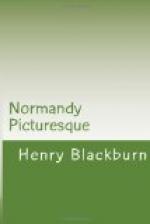The churches at Falaise should not pass unnoticed; but we will not weary the reader with any detailed description. Artists will especially delight in the view of a fourteenth-century church close to the castle, with its chancel with creepers growing over it, and peeping out between the stones; and historians will be interested in the laconic inscription on its walls, ’rebuilt in 1438, a year of war, death, plague, and famine.’ If such artists as Brewer, or Burgess, would only come here and give us drawings of these streets (of one especially, taking in the cathedral at the end, with its stone walls built over by shops, as at Pont Audemer), they would be very interesting to Englishmen. Antiquaries will regret to learn that in the year 1869, the west end of a church is obliterated, as in the next illustration; that the shop of one ’M. Guille, peruquier,’ reposes against the window, and that two other, quite modern, buildings lean against its walls. An old Norman arch is carved immediately above the window we have sketched, and completes the picture.
[Illustration]
It is, of course, not very easy to sketch undisturbed in the streets of Falaise; and both in the churches and in the castle the showman is perpetually treading on the traveller’s heels. Everywhere we turn, in the neighbourhood of the castle, we are reminded of historic deeds of valour, and of deadly fights in the middle ages; and every day that we remain in the town, we are reminded (by the crowds of farmers, horsedealers, and others, who are busy at the great fair held here twice a year) of our own, by comparison, very trifling business at Falaise. We are making a drawing of the great rocks near the castle, and of the valley below, every step of which is made famous by the memory of the Conqueror; when our studies are disturbed, not by tourists but by natives of the town; once by a farmer to see his good horses, which indeed he had, at the stables at the ‘hotel of the beautiful Star,’ where there were at least fifty standing for sale; and once, by a small boy, who carries a tray full of little yellow books called ’La Lanterne de Falaise,’ with a picture on the cover of the castle tower, and a huge lantern slung from the battlements! We purchase a copy, to get rid of the last intruder, and find it to be a ’Revue, satirique et humouristique,’ treating of divers matters, including ’faits atroces et chiens perdus’!
Now without being accused of misanthropy, we may remark that there are times and places when an Englishman would rather be ‘let alone,’ and that the precincts of Falaise are certainly of them. These century-wide contrasts and concussions, jar so terribly sometimes, that we are half-inclined to ask with M. de Tocqueville, whether we do not seem to be on the eve of a new Byzantine era, in which ’little men shall discuss and ape the deeds which great men did in their forefathers’ days.’[39] The refrain in this nineteenth century is, ’still




